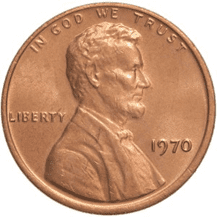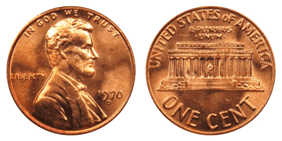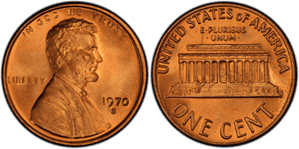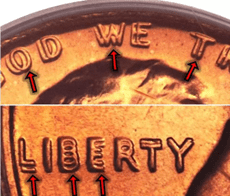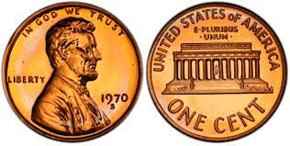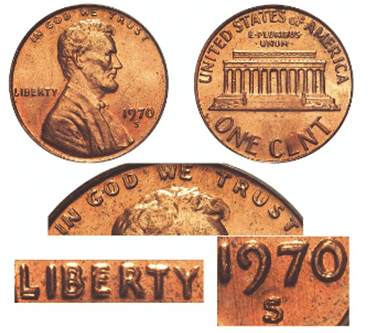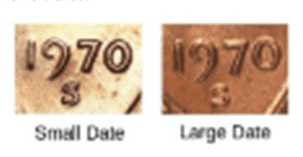What Makes a 1970 Penny Valuable?
One of the greatest appeals of coins and coin collecting is the fact that coins can represent a snapshot of the historical events that happened in the year the coin was minted. In the case of the 1970 Lincoln Penny, this coin was minted during a period of great tension in the United States.
Overseas, the Vietnam War was in full swing. President Richard Nixon of the United States launched an invasion of Cambodia, escalating the Vietnam War. On the home front, protests had turned deadly, with millions demonstrating throughout the United States, and student strikes had shut down university campuses. National Guard troops kill four protestors at Kent State University in Ohio.
Pennies were comprised of 95 percent copper and 5 percent zinc in 1970. The Philadelphia, Denver (“D”), and San Francisco (“S”) Mints also produced 1970 Lincoln pennies. Many coin collectors are on the lookout for the 1970-S Lincoln pennies, which exist in two different kinds; the small date, and the large date penny, with the former being the most sought after, particularly in uncirculated condition.
Contents
- 1 What Makes a 1970 Penny Valuable?
- 2 1970 Penny Varieties
- 3 How Much Is A 1970 Lincoln Penny Worth Today?
- 4 Rare Examples of the 1970 Lincoln Penny
- 5 How To Tell The Difference Between Small Date and Large Date?
- 6 What are the Factors that Affect the Value of the 1970 Lincoln Penny?
- 7 How Coins are Graded
- 8 Where To Buy Or Sell 1970 Lincoln Pennies?
- 9 FAQs
1970 Penny Varieties
1) 1970 Penny Without Mint Mark
Year: 1970
Face Value: $0.01
Composition: 95% copper, 5% zinc
Total Weight: 3.11 grams
Diameter: 0.750 in. 19.05 mm
Thickness: 0.0598 inches (1.52 mm)
Edge: Plain
Minted in: Philadelphia
Quantity Minted : 1,898,315,000
2) 1970-D Penny
Year: 1970
Face Value: $0.01
Composition: 95% copper, 5% zinc
Total Weight: 3.11 grams
Diameter: 0.750 in. 19.05 mm
Thickness: 0.0598 inches (1.52 mm)
Edge: Plain
Minted in: Denver
Quantity Minted : 2,891,438,900
3) 1970-S Penny (Large Date)
Year: 1970
Face Value: $0.01
Composition: 95% copper, 5% zinc
Total Weight: 3.11 grams
Diameter: 0.750 in. 19.05 mm
Thickness: 0.0598 inches (1.52 mm)
Edge: Plain
Minted in: San Francisco
Quantity Minted : 690,560,004 (Both types)
4) 1970-S Small Date Penny
Year: 1970
Face Value: $0.01
Composition: 95% copper, 5% zinc
Total Weight: 3.11 grams
Diameter: 0.750 in. 19.05 mm
Thickness: 0.0598 inches (1.52 mm)
Edge: Plain
Minted in: San Francisco
Quantity Minted : 690,560,004 (Both types)
5) 1970-S Large Date Doubled Die Penny
Year: 1970
Face Value: $0.01
Composition: 95% copper, 5% zinc
Total Weight: 3.11 grams
Diameter: 0.750 in. 19.05 mm
Thickness: 0.0598 inches (1.52 mm)
Edge: Plain
Minted in: San Francisco
Quantity Minted : Unknown (About 50 known)
6) 1970-S Proof Penny (Large Date)
Year: 1970
Face Value: $0.01
Composition: 95% copper, 5% zinc
Total Weight: 3.11 grams
Diameter: 0.750 in. 19.05 mm
Thickness: 0.0598 inches (1.52 mm)
Edge: Plain
Minted in: San Francisco
Quantity Minted : 2,632,810 (Both Types)
7) 1970-S Small Date Proof Penny
Year: 1970
Face Value: $0.01
Composition: 95% copper, 5% zinc
Total Weight: 3.11 grams
Diameter: 0.750 in. 19.05 mm
Thickness: 0.0598 inches (1.52 mm)
Edge: Plain
Minted in: San Francisco
Quantity Minted : 2,632,810 (Both types)
How Much Is A 1970 Lincoln Penny Worth Today?
The following chart can be used as an indicator of the value of the different types of 1970 Lincoln Penny:
| Coin | Mintage | Mint Location | Value |
| 1970 Penny | 1,898,315,000 (1.898 billion) | Philadelphia | 25-50+ Cents (Dependent on grade) |
| 1970 D Penny | 2,891,438,900 (2.891 billion) | Denver | 25-50+ Cents (Dependent on grade) |
| 1970 S Penny Small Date | 690,560,004 minted of all kinds | San Francisco | $40+ (Dependent on grade) |
| 1970 S Penny Large Date | 690,560,004 minted of all kinds | San Francisco | 25-50+ Cents (Dependent on grade) |
| 1970-S proof Penny | 2,632,810 minted of all kinds | San Francisco | $1+ (Dependent on grade) |
| 1970-S Small Date Proof penny | 2,632,810 minted of all kinds | San Francisco | $30+ (Dependent on grade) |
| 1970-S Penny With Doubled Die | Unknown how many were minted; around 50 in known circulation | San Francisco | $1500+ (Due to how uncommon this coin is, the price can greatly vary) |
Rare Examples of the 1970 Lincoln Penny
1) 1970 Penny Without Mint Mark
The presence or absence of a mintmark can signify substantial changes in the value of a coin in the United States. If a US coin’s date is written without a mintmark, it signifies the piece has no mintmark and was produced (typically) in Philadelphia. Coins produced in Philadelphia without mintmarks are occasionally referred to as 1927-P, despite the fact that there is no mintmark on the piece.
In the last 40 years, the majority of deviations to the rule that US coins without mintmarks are from Philadelphia have happened. For detailed information on this coin look at the first entry on our list.
2) 1970-S Penny With Doubled Die (Obverse)
The 1970 S penny has an extremely rare mistake variant. The date and the design components are manufactured twice on the obverse side of the coin. A doubled die error is what this is known as. There isn’t enough recent sales data to define a price range because these coins are extremely rare, so those in possession of this rare coin can really set their own price.
How To Tell The Difference Between Small Date and Large Date?
The 1970 S pennies come in a variety of designs which is why they appeal so much to collectors. There are two types of pennies: those with a tiny date and those with a large date. The date on the small date pennies is a high 7, whereas the date on the large date pennies is a low 7. For a visual representation, see the graphic below.
You can also tell the difference between the two date types by looking at the following:
-
-
- It’s a 1970-S Small Date penny if the tail of the “9” loop in the date points directly to the “7.” It’s a 1970-S Large Date cent if the end of the “9” loop points to the top of the mintmark.
- The top of the “7” in the date will be level with the tops of the “1,” “9,” and “0” in the date on 1970-S Small Date Lincoln cents. The top of the “7” is buried below the imaginary plane that aligns the tops of the other numerals in the date on 1970-S Large Date pennies.
- On the 1970-S Small Date Lincoln cents, the bottom of the “7” in the date is on the same plane as the “1” and “0” in the date. The base of the “7” on 1970-S Large Date Lincoln cents slides just below the imaginary line that runs along the bottoms of the “1” and “0” of the date.
- The inscription LIBERTY is poorly struck on most 1970-S Small Date Lincoln pennies, although LIBERTY is often stronger on 1970-S Large Date cents. LIBERTY is also weak on certain 1970-S Large Date pennies, so this diagnosis isn’t always accurate. As a result, this indication should be utilized in conjunction with the changes in the date’s appearance rather than as a diagnostic indicator on its own.
-
What are the Factors that Affect the Value of the 1970 Lincoln Penny?
Demand is High
Anything that is scarce is in high demand, and the same is true for valuable coins. Mintage Supply, like demand, is an important aspect that affects the value of collector coins at any given time. Obviously, something that is readily available commands a lesser price than something that is rare.
The Metal’s Intrinsic Worth
Because of their intrinsic metal worth, some coins are more desirable and more expensive.
Population in Circulation
Coins that are too worn out and damaged are removed from circulation, limiting the number of survivors at any given time. The smaller a coin’s surviving population is, the rarer it becomes and the higher its value.
Condition and Grade
When determining the worth of a collectible coin, you must take into account its grade and condition. Grading, in essence, establishes a coin’s condition, and its grade defines its value. A coin with a flawless mint grade is worth far more than an identical coin with a minor flaw. The coin’s attractiveness, color, shine, strike, and preservation are considered to define its grade.
Third-party grading companies are frequently used to determine the grade of coins in an objective manner. When purchasing a coin as a collectible, make sure it is certified and that the grade is correct.
Historical Significance
A coin’s unique history is an unusual factor that determines its worth. A coin that would otherwise be worthless becomes an uncommon and valuable collectible because it has historical significance, such as being linked to a famous king or a significant historical event.
How Coins are Graded
The Sheldon Scale is used by numismatists to provide a numerical value to coins. The Sheldon Scale goes from poor (P-1) to perfect mint state (P-1) (MS-70). Coins were originally evaluated using words to reflect their condition (Good, Fair, Excellent, Etc.). Unfortunately, coin collectors and dealers had different ideas about what each of these terms represent.
Professional numismatists joined together in the 1970s and established CoinGrading standards. These numismatists now assign grades at key places on the seventy-point scale, using the most regularly utilized numeric points in conjunction with the original adjective grade. The following are the most common coin grades:
-
-
- (P-1) Poor – Indistinguishable and probably damaged; if used, must have a date and mintmark; otherwise, rather battered.
- (FR-2) Fair – Nearly smooth, but without the damage that a coin graded Poor often possesses. The coin must have enough detail to be identified.
- (G-4) Fair – Inscriptions have merged into the rims in some areas, and important elements have been mostly erased.
- (VG-8) Very Good- A little weathered, but all of the primary design elements are visible, albeit faintly. There is little if any, central detail left.
- (F-12) Good – The item is very worn, yet the wear is even, and the overall design details stand out clearly. Rims are almost completely isolated from the field.
- (VF-20) Very Fine – Moderately weathered, with some finer features still visible. The motto or all letters of LIBERTY are readable. Both sides of the coin have entire rims that are separated from the field.
- (EF-40) Extremely Fine – Gently used; all gadgets are visible, and the most important ones are bold. The finer details are bold and clear, however, light wear may be seen.
- (AU-50) Uncirculated – Slight evidence of wear on the coin’s design’s high points; may have contact marks; eye appeal should be adequate.
- (AU-58) Uncirculated Choice – Slight traces of wear, no severe contact marks, almost full mint shine, and great eye appeal.
- (MS-60) Mint State Basal – Strictly uncirculated; no indication of wear on the coin’s highest points, but an unsightly coin with reduced luster, visible contact marks, hairlines, and other flaws.
- (MS-63) Mint State Acceptable – Uncirculated, but with contact scratches and nicks, little reduced shine, but otherwise appealing appearance. The strike is weak to average.
- (MS-65) Mint State Choice – Uncirculated with great mint shine, very little contact blemishes, and exceptional eye appeal. The strike is unusually severe.
- (MS-68) Mint State Premium Quality – Uncirculated with superb luster, no obvious contact marks to the naked eye, and exceptional eye appeal. The strike is quick and appealing.
- (MS-69) Almost Perfect Mint State – Uncirculated with perfect brilliance, a sharp and appealing strike, and extremely good eye appeal. A near-perfect coin with minor imperfections in the planchet, strike, and contact markings (seen only under 8x magnification).
- (MS-70) Mint State Perfect – Under 8x magnification, there are no tiny imperfections discernible; the strike is crisp, and the coin is perfectly centered on a beautiful planchet. Rarely seen on a coin, this coin is bright and whole, with original luster and exceptional eye appeal.
-
Where To Buy Or Sell 1970 Lincoln Pennies?
As mentioned, the common versions of the 1970 Lincoln Pennies are still in general circulation, and you may even come across one in your day to life. If you’re looking to buy or sell this coin then you should first do your research so you know what to look for or to identify important factors of the coin you’re selling.
Once you have a good idea of what you’re looking for or what you have to sell there are multiple options available to you. For lower value coins online sales sites such as eBay are usually pretty reliable.
However, coins with greater rarity or value should be bought or sold through a coin dealer or registered auction houses such as CGB Numismatics in Paris, or Rare Coins.
FAQs
What does D mean on the penny?
On a Lincoln Penny, the ‘D’ is a mint mark which tells us that the penny was minted in Denver.
What does S mean on the penny?
On a Lincoln Penny, the ‘S’ is a mint mark which tells us that the penny was minted in San Francisco.
What is the rarest 1970 penny?
The Rarest Lincoln Penny is the 1970-S Penny With Doubled Die (Obverse), there are only around 50 of these known in circulation, and prices for this coin start in the thousands.

